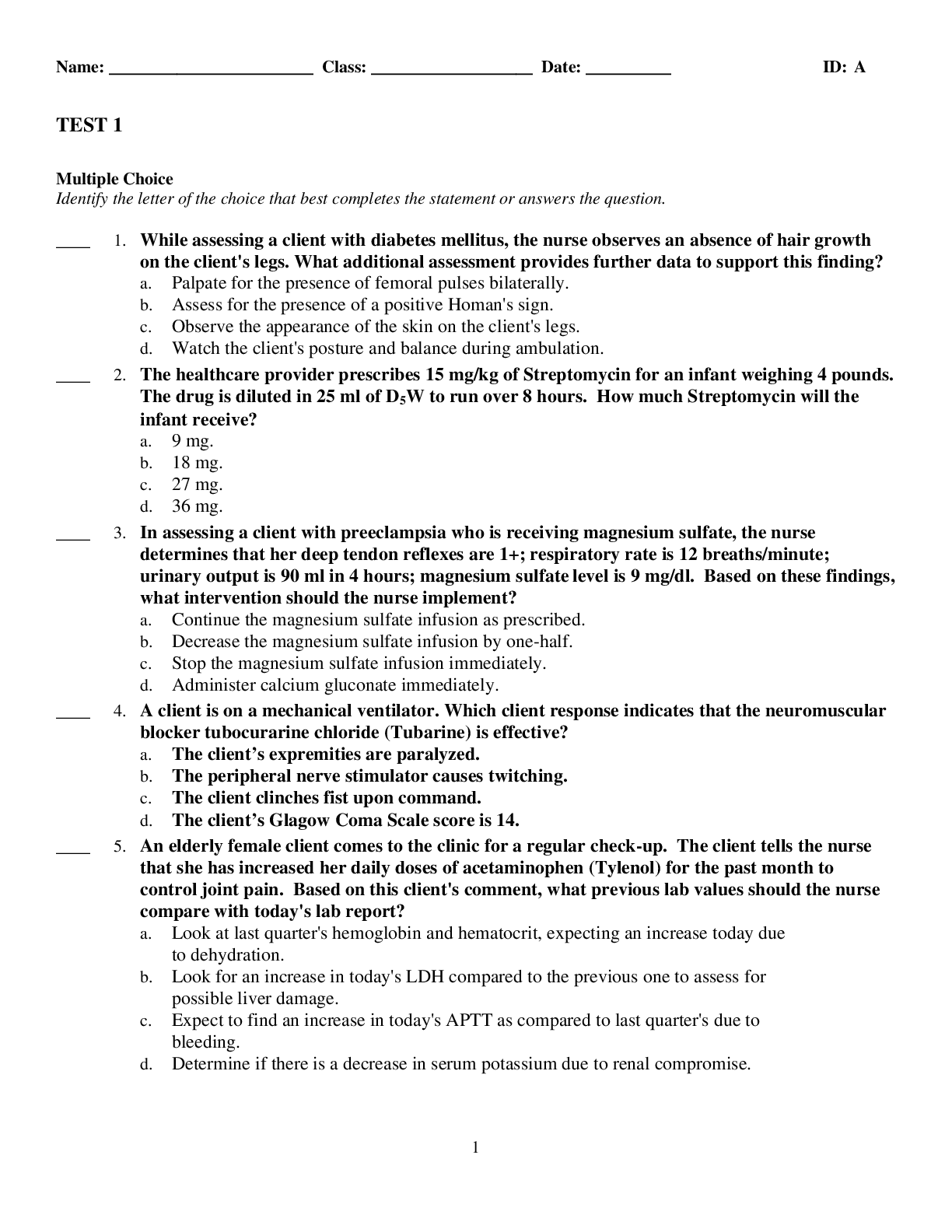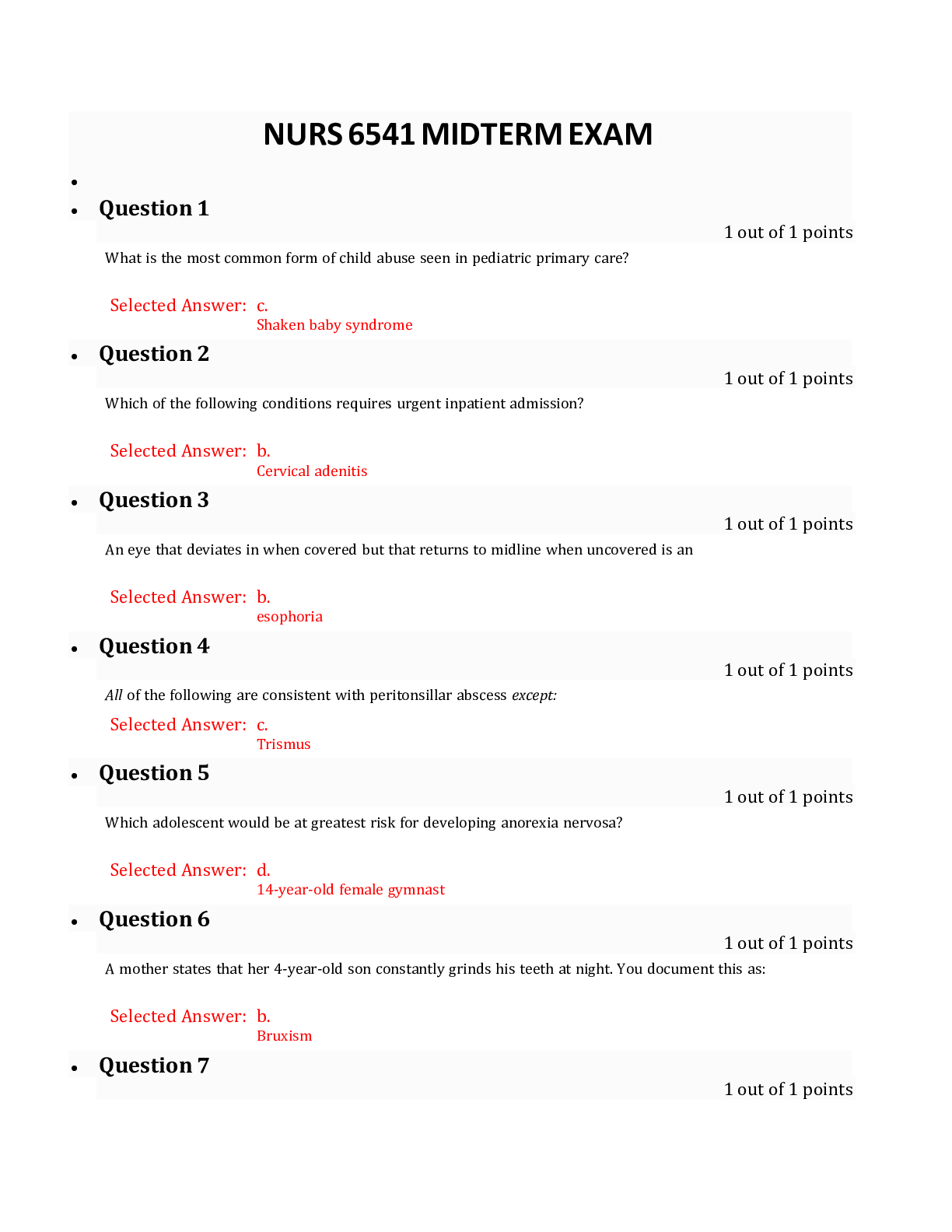NURSING MISC 3P EXAM QUESTIONS AND ANSWERS (Latest Update)
Document Content and Description Below
Questions 1 When performing a visual acuity test, the nurse practitioner notes 20/30 in the left eye and 20/60 in the right eye. The next step is to A- Have the patient return in 2 weeks for a follo... w-up vision screen B- Dilate the eyes and retest C- Refer the patient to an ophthalmologist D- Document this as a normal finding. Question 2 The American Psychiatric Association’s Diagnostic and Statistical Manual Disorder fifth edition (DMS-5) describes Munchausen Syndrome by proxy as A- A self-inflicted injury to gain attention B- A caregiver making up or causing an illness or injury in a person under his or her care C- An abusive behavior that does not involve the caregiver D- A situation in which the abuser is often inattentive and uncaring toward the victim Question 3 Symptoms of depression are a side effect of which neurotransmitter medication? [There are 3 categories of neurotransmitters in the brain: small molecules for fast action/excitatory transmission = glutamate & GABA; small molecules for slower modulation of activity = dopamine & serotonin; Peptides = endorphins, cannabindoids, oxytocin) A- Dopamine B- B- Gabapentin C- C- Mu D- Cortisol Question 4 The right lymphatic ducts drain into what part of the circulatory system? (There are two lymph ducts, the right lymphatic duct and the thoracic duct. The right drains lymph from the right upper limb, the right side of thorax, and the right halves of head and neck. The thoracic duct drains lymph into the circulatory system between the left subclavian and the left internal jugular veins) A- Arterial B- Venous C- Arteriovenous system D- Capillary bed Question 5 Which lesion is dark, raised and asymmetric with irregular borders? A- Nevus (the medical term for a mole. Nevi are very common. Most people have between 10 and 40. Common nevi are harmless collections of colored cells. They typically appear as small brown, tan, or pink spots) B- Actinic (a rough, scaly patch on your skin that develops from years of exposure to the sun. It's most commonly found on your face, lips, ears, back of your hands, forearms, scalp or neck) C- Keratoacanthoma (a dome-shaped lump or tumor that grows on your skin) D- Melanoma (the most serious type of skin cancer, develops in the cells (melanocytes) that produce melanin — the pigment that gives your skin its color. Melanoma is asymmetric, irregular border, change in color, change in diameter, and evolved over time [ABCDE]) Question 6 A pediatric patient has areas of scaling on the scalp, with round patches of alopecia. This clinical finding is consistent with A- Tinea capitis (Ringworm of the scalp is not really a worm, but a fungal infection. It gets the name ringworm because the fungus makes circular marks on the skin, often with flat centers and raised borders. Also called Tinea capitis, this infection affects your scalp and hair shafts, causing small patches of itchy, scaly skin) B- Seborrheic dermatitis (a common skin condition that mainly affects your scalp. It causes scaly patches, red skin and stubborn dandruff. Seborrheic dermatitis can also affect oily areas of the body, such as the face, sides of the nose, eyebrows, ears, eyelids and chest. For infants, the condition is known as cradle cap and causes crusty, scaly patches on the scalp.) C- Trichotillomania (hair-pulling disorder, is a mental disorder that involves recurrent, irresistible urges to pull out hair from your scalp, eyebrows or other areas of your body, despite trying to stop) D - Alopecia areata (a condition that causes hair to fall out in small patches, which can be unnoticeable. These patches may connect, however, and then become noticeable. The condition develops when the immune system attacks the hair follicles, resulting in hair loss) Question 7 A patient with an acute presentation of acute aortic regurgitation (AR) typically presents with sudden severe shortness of breath, lower extremity edema, a rapid heartbeat, and A- Dry mouth B- Chest pain C- Decreased blood pressure E - Systolic murmur Question 8 Which of the following conditions is associated with chronic bloody diarrhea? A- Irritable bowel syndrome (a common disorder that affects the large intestine. Signs and symptoms include cramping, abdominal pain, bloating, gas, and diarrhea or constipation, or both. IBS is a chronic condition that you'll need to manage long term) B- Crohn’s disease (an inflammatory bowel disease (IBD). It causes inflammation of your digestive tract, which can lead to abdominal pain, severe diarrhea, blood in stool, fatigue, weight loss and malnutrition) C- Hepatitis A (Hepatitis A is a highly contagious liver infection caused by the hepatitis A virus. You're most likely to get hepatitis A from contaminated food or water or from close contact with a person or object that's infected. signs and symptoms can include: Fatigue, Sudden nausea and vomiting, Abdominal pain or discomfort, especially on the upper right side beneath your lower ribs (by your liver), Clay-colored bowel movements, Loss of appetite, Low-grade fever, Dark urine, Joint pain, Yellowing of the skin and the whites of your eyes (jaundice), Intense itching) D- Celiac disease (an immune reaction to eating gluten, a protein found in wheat, barley and rye. Over time, this reaction damages your small intestine's lining and prevents it from absorbing some nutrients (malabsorption). The intestinal damage often causes diarrhea, fatigue, weight loss, bloating and anemia, and can lead to serious complications) Question 9 Which condition is caused by an insufficient production of intrinsic factor by the gastric mucosa and vitamin B insufficiency? A- Diarrhea B- Pernicious anemia (When your body can’t make enough healthy red blood cells because it lacks vitamin B-12) C- Osteoporosis D- Muscle weakness Question 10 A 32-year old woman presents with dull puffiness of the eyes with pronounced non-pitting periorbital edema. This finding is suggestive of what condition? A- Nephrotic syndrome (a kidney disorder that causes your body to pass too much protein in your urine. Nephrotic syndrome is usually caused by damage to the clusters of small blood vessels in your kidneys that filter waste and excess water from your blood. The condition causes swelling, particularly in your feet and ankles, and increases the risk of other health problems) B- Myxedema (severely advanced hypothyroidism. This is a condition that occurs when your body doesn’t produce enough thyroid hormone. The classic skin changes are: swelling of your face, which can include your lips, eyelids, and tongue, swelling and thickening of skin anywhere on your body, especially in your lower legs) C- Cushing’s syndrome (when your body is exposed to high levels of the hormone cortisol for a long time. Cushing syndrome, sometimes called hypercortisolism, may be caused by the use of oral corticosteroid medication. The condition can also occur when your body makes too much cortisol on its own. Too much cortisol can produce some of the hallmark signs of Cushing syndrome — a fatty hump between your shoulders, a rounded face, and pink or purple stretch marks on your skin. Cushing syndrome can also result in high blood pressure, bone loss and, on occasion, type 2 diabetes) E-Sinusitis (You may feel pressure around your eyes, cheeks and forehead. Perhaps your head throbs. Sinusitis usually occurs after a viral upper respiratory infection or cold and includes thick, discolored nasal mucus, decreased sense of smell, and pain in one cheek or upper teeth) Myxedematous coma, which is manifested by coma, hypothermia, severe fluid and electrolyte imbalances, and cardiovascular collapse, is a life-threatening, end-stage expression of hypothyroidism. ■■ Hyperthyroidism has an effect opposite to that of hypothyroidism. It produces an increase in metabolic rate and oxygen consumption, increased use of metabolic fuels, and increased sympathetic nervous system responsiveness. Manifestations include nervousness, irritability, a fine muscle tremor, weight loss despite an increased appetite, excessive sweating, muscle cramps, and heat intolerance. Graves’ disease is characterized by the triad of hyperthyroidism, goiter, and ophthalmopathy (exophthalmos or protruding eyeballs) or dermopathy (pretibial myxedema). ■■ Thyroid storm or crisis, which is manifested by a very high fever, extreme cardiovascular effects (tachycardia, congestive failure, and angina), and severe central nervous system effects (agitation, restlessness, and delirium), is an extreme and life-threatening form of thyrotoxicosis. Question 11 A 52-year-old woman is inquiring about estrogen replacement therapy for symptoms of menopause. Which of the following is a contraindication? A - History of phlebitis B- Prior or present migraine headaches C- Family history of lung cancer D - Prior breast or uterine carcinoma Question 12 Patient with asthma have a pathological finding of: A -Necrosis of small airways B- Absence of goblet cells C- Absence of ciliary regeneration D - Hypertrophy of smooth muscle (Epithelial to mesenchymal transition plays an important role in airway remodeling. These epithelial and mesenchymal cells cause persistence of the inflammatory infiltration and induce histological changes in the airway wall, increasing thickness of the basement membrane, collagen deposition and smooth muscle hypertrophy and hyperplasia. Resulting of airway inflammation, airway remodeling leads to the airway wall thickening and induces increased airway smooth muscle mass, which generate asthmatic symptoms) Question 13 A 65-year-old patient with a history of a deep vein thrombosis (DVT) is being treated for a dental abscess. Which antibiotics is safe to use with warfarin (Coumadin). [Some antibiotics, such as penicillins, quinolones, metronidazole and cephalosporins can cause unwanted side effects in warfarin users or decrease warfarin's effectiveness] A- Amoxicillin (Amoxil) [Penicillin abx] B- Trimethoprim/ sulfamethoxazole (Bactrim) [known as a co-trimoxazole antibiotic used to treat a variety of bacterial infections] C- Ciprofloxacin (Cipro) [a fluoroquinolone antibiotic used for bacterial infections] D- Clarithromycin (Biaxin) [a macrolide antibiotic that fights bacteria infections that affect the skin and respiratory system. Also used to treat stomach ulcers caused by H. pylori] Question 14 Primary syphilis is characterized by what type of lesion [Primary syphilis: The first sign of syphilis is a small sore, called a chancre (SHANG-kur). The sore appears at the spot where the bacteria entered your body. While most people infected with syphilis develop only one chancre, some people develop several of them. The chancre usually develops about three weeks after exposure. Many people who have syphilis don't notice the chancre because it's usually painless, and it may be hidden within the vagina or rectum. The chancre will heal on its own within three to six weeks. Secondary syphilis: Within a few weeks of the original chancre healing, you may experience a rash that begins on your trunk but eventually covers your entire body — even the palms of your hands and the soles of your feet. This rash is usually not itchy and may be accompanied by wart-like sores in your mouth or genital area. Some people also experience hair loss, muscle aches, a fever, a sore throat and swollen lymph nodes. These signs and symptoms may disappear within a few weeks or repeatedly come and go for as long as a year. Latent syphilis: If you aren't treated for syphilis, the disease moves from the secondary stage to the hidden (latent) stage, when you have no symptoms. The latent stage can last for years. Signs and symptoms may never return, or the disease may progress to the third (tertiary) stage. Tertiary syphilis: About 15% to 30% of people infected with syphilis who don't get treatment will develop complications known as late (tertiary) syphilis. In the late stage, the disease may damage your brain, nerves, eyes, heart, blood vessels, liver, bones and joints. These problems may occur many years after the original, untreated infection. Neurosyphilis: At any stage, syphilis can spread and, among other damage, cause damage to the brain and nervous system (neurosyphilis) and the eye (ocular syphilis). Congenital syphilis: Babies born to women who have syphilis can become infected through the placenta or during birth. Most newborns with congenital syphilis have no symptoms, although some experience a rash on the palms of their hands and the soles of their feet. Later signs and symptoms may include deafness, teeth deformities and saddle nose — where the bridge of the nose collapses. However, babies born with syphilis can also be born too early, be born dead (stillborn) or die after birth. A- A cluster of scattered vesicles B- Chancre C- Papule of many shapes D- Nontender indurated penile nodule Question 15 What is the area of fundal height palpation on a woman who is 12 weeks pregnant? [Fundal Height during Pregnancy: The fundus will be found above the symphysis pubis at 12 weeks. The fundus will be found at the belly button (umbilicus) at 20 weeks. As mentioned above, after about 20-36 weeks the fundal height measurement should almost match the gestational age give or take 2 cm] A- At the level of the umbilicus (20 weeks) B- At the level of the symphysis pubis (12 weeks) C- Midway between the symphysis and umbilicus (16-19 weeks) D- Below the symphysis pubis (less than 12 weeks) Question 16 Which of the following is NOT associated with assessment finding in a patient diabetic retinopathy? [a diabetes complication that affects eyes. It's caused by damage to the blood vessels of the light-sensitive tissue at the back of the eye (retina). At first, diabetic retinopathy may cause no symptoms or only mild vision problems. Eventually, it can cause blindness. diabetic retinopathy symptoms may include: Spots or dark strings floating in your vision (floaters), Blurred vision, Fluctuating vision, Impaired color vision, Dark or empty areas in your vision, Vision loss] A- Papilledema (swelling of the optic nerve---optic disk) B- Dot and blot hemorrhages (microaneurysms rupture in the deeper layers of the retina, such as the inner nuclear and outer plexiform layers) C- Microaneurysms (a tiny area of blood protruding from an artery or vein in the back of the eye. These protrusions may open and leak blood into the retinal tissue surrounding it) D- Cotton wool spots (an abnormal finding on funduscopic exam of the retina of the eye. They appear as fluffy white patches on the retina. They are caused by damage to nerve fibers and are a result of accumulations of axoplasmic material within the nerve fiber layer) Question 17 A 3-year-old child has enterobiasis(PINWORM). When should the dose of mebendazole (Vermox) be repeated? [The medications used for the treatment of pinworm are either mebendazole, pyrantel pamoate, or albendazole. Any of these drugs are given in one dose initially, and then another single dose of the same drug two weeks later. The second dose is to prevent re-infection by adult worms that hatch from any eggs not killed by the first treatment] A- In 3 days B- In 1 week C- In 2 weeks D -In 3 weeks Question 18 Which area does not allow lymphatic fluid to be drained from the right lymph duct? [The right lymphatic duct, also called the right thoracic duct, is about 1.25 cm long. It drains lymphatic fluid from the right thoracic cavity (this is the section of the trunk on the upper right side), the right arm, and from the right side of the neck and the head. In some people, it also drains lymph from the left lung’s lower lobe] A -The right side of the head B- The right upper thorax C- The right arm D-The right leg Question 19 Snellen chart evaluation indicates that a patient’s vision is 20/30. What is the proper description of this result? A- At 20 feet, this patient can see what a person with normal vision can see at 30 feet B- At 30 feet, this patient can see what a person with normal vision can see at 30 feet C- At 20 feet, this patient can see what few people can see at 30 feet D- This patient has sight abilities that are worse than a patient with 20/40 vision Question 20 Based on the mechanism of hearing, sensorineural loss in an adult involves the [The majority of acquired hearing loss, including presbycusis, is caused by irreversible damage to the sensorineural tissues of the cochlea] A- Cochlea and the cochlea nerve B- External ear canal and the middle ear C- Ossicles and the inner ear D- Transfer of sounds from the external environment into the external auditory canal Question 21 Which of the appropriate medication choice for a 31-year-old pregnant patient diagnosed with a urinary tract infection? A- Cefuroxime (Zinacef) [used to treat HEENT and Respiratory infections] or Nitrofurantoin (Macrobid) B- Nitrofurantoin (Macrobid) or Ciprofloxacin (Cipro) C- Ciprofloxacin (Cipro) or Tetracycline (Sumycin) [not recommended in PG] D- Tetracycline (Sumycin) [Not recommended/unsafe in PG] or Amoxicillin (Amoxil) Question22 Pregnant women are evaluated for syphilis with serology testing because A- Syphilis during pregnancy predisposes the fetus to spontaneously abort or the newborn to have congenital syphilis. B- Hormonal changes associated with pregnancy may trigger activation of talent syphilis C- Syphilis may be passed to the fetus beginning in the third trimester D- Untreated syphilis can cause neonatal respiratory distress Penicillin G benzathine (bicillin L-A) given as 3 intramuscular doses over 2 weeks. Question 23 Which of the following is a typical finding in a patient with a meniscal tear? A- A positive McMurray’s test (The McMurray test, also known as the McMurray circumduction test is used to evaluate individuals for tears in the meniscus of the knee) B- Positive anterior drawer test (commonly used in orthopedic examinations to test for anterior cruciate ligament (ACL) integrity) C- Audible click at the joint line (usually occurs at the hip) D- Fixed patellar subluxation (a partial dislocation of the kneecap) Question 24 Hyperkalemia is associated with: A- Increased blood pressure B- Alpha blockers C- Diminished renal function D- Loop diuretics Question 25 Short bands of tough, flexible, ropelike, collagen fibrils that connect two bones is called: A- Tendons (Type of tissue that connects muscle to bone) B- Fibrous connective tissue (Irregularly-arranged fibrous connective tissues are found in areas of the body where stress occurs from all directions, such as the dermis of the skin) C- Ligaments (bands of tough elastic tissue around your joints. They connect bone to bone, give your joints support, and limit their movement. A short band of tough, flexible, fibrous connective tissue that connects two bones or cartilages or holds together a joint (Quizlet)) D- Cartilage (Resilient and smooth elastic tissue, rubber-like padding that covers and protects the ends of long bones at the joints) Question 26 The finding of a dome-shaped lesion in the dermis that forms a benign closed, firm sac attached to the epidermis A- A keloid (extra scar tissue of smooth, hard growth) B- A tophi (when crystals of the compound known as sodium urate monohydrate, or uric acid, builds up around your joints. Tophi often look like swollen, bulbous growths on your joints just under your skin) C- a cutaneous cyst (Formerly called a sebaceous cyst, a dome- shaped lump in the dermis forms a benign closed firm sac attached to the epidermis. A dark dot (blackhead) may be visible on its surface) D- chondrodermatistis (a skin condition that affects the cartilage of the ear. It’s a painful nodule, which may or may not have a scab on it, that grows over a period of time) Question 27 What symptoms would lead the nurse practitioner to suspected atypical community acquired pneumonia in an 18-year-old living in ... A- a low-grade fever, malaise, and clear lung fields on auscultation B- a low-grade fever, malaise, and crackles audible throughout the lung fields C- temperature of 101 f, sore throat, and diminished breath sounds on auscultation D- temperature of 102 f, dyspnea, and diminished lung sounds on auscultation Question 28 Vitamins prescribed for pregnant women should contain what two components? A- Folic acid and vitamin C B- Iron and vitamin B12 C- Vitamin D and Iron D- Folic acid and Iron Question 29 Which medication is indicated for patients with generalized anxiety disorder (GAD)? A- Buspirone (Buspar) B- Citalopram (Celexa) C- Imipramine (Toframil) D- Bupropion HCL (Wellbutrin) Question 30 A prostate gland that is found to be tender, swollen, boggy, and warm on a digital rectal exam is consistent with: A- A normal prostate gland B- Acute bacterial prostatitis C- Benign prostatic hyperplasia D- Carcinoma of the prostate Question 31 Which medication can cause a false positive result for amphetamines in a urine drug screen? A- Metformin B- B- Lisinopril C- C- Glyburide D- D- Bupropion Question 32 Fine, silky appearance of the hair is a common finding in: A- Hypothyroidism B- Hyperthyroidism C- Type 2 diabetes D- Celiac disease Question 33 Which of the following is commonly associated with increased risk for prostatic hypertrophy? A- Constipation B- Fecal incontinence C- Urinary tract infections D- Prostate cancer Question 34 Patients with bacterial meningitis experience headache symptoms due to: A- Meningeal erythema B- Increased intracranial pressure C- Meningeal irritation D- Swelling of the spinal cord Question 35 A 42-year-old woman with a past medical history of migraine headaches is requesting prophylactic medication treatment. Which medication should not be ... A- Sumatriptan (Limitrex) B- Amitriptyline (Elavil) C- Verapamil (Verelan) D- Metoprolol (Lopressor) Question 36 What diagnostic test is performed to diagnose acute lymphocytic leukemia (ALL)? A- A complete blood count with differential B- Magnetic resonance imaging C- A nuclear bone scan D- A bone marrow examination Question 37 Which of the following medications should NOT be prescribed during an acute gout flare? A- Colchicine (Colcrys) B- Allopurinol (Zyloprim) C- Steroids D- NSAIDs Question 38 A 42-year-old woman with a past medical history of migraine headaches is requesting prophylactic medication treatment which medication is NOT be prescribed? A- Sumatriptan (Imitrex) B- Amitriptyline (Elavil) C- Verapamil (Verelan) D- Metoprolol (Lopressor) In most cases, preventative treatment must be taken daily for months to years. First-line agents include β-adrenergic blocking medications (e.g., propranolol, atenolol), anti- depressants (amitriptyline), and antiseizure medications (e.g., divalproex, valproic acid). A medication is used to treat the acute symptoms of migraine headache. First-line agents include aspirin and other NSAIDs (e.g., naproxen sodium, ibuprofen), combinations of acetaminophen, acetylsalicylic acid, and caffeine; serotonin (5-HT1) receptor agonists (e.g., sumatriptan); ergotamine derivatives (e.g., dihydroergot- amine); and antiemetic medications (e.g., ondansetron, metoclopramide). Non-oral routes of administration may be preferred in individuals who develop severe pain rapidly or on awakening, or in those with severe nau- sea and vomiting. Both sumatriptan and dihydroergota- mine have been approved for intranasal administration. For intractable migraine headache, dihydroergotamine may be administered parenterally with an antiemetic or opioid analgesic.49 Frequent use of abortive headache medications may cause rebound headache. Because of the risk of coronary vasospasm, the 5-HT1 receptor agonists should not be given to persons with coronary artery disease. Ergotamine preparations can cause uter- ine contractions and should not be given to pregnant women. They also can cause vasospasm and should be used with caution in persons with peripheral arterial disease. Question 39 A pediatric patient has areas of scaling on the scalp, with round patches alopecia. This clinical finding is consistent with: A- Tinea capitis B- Seborrheic dermatitis C- Trichotillomania D- Alopecia areata Question 40 What is the appropriate prophylactic medication for an 18-year-old woman with a past medical history of migraine headache? A- Sumatriptan (Imitrex) B- Propranolol (Inderal) C- Ibuprofen (Motrin) D- Dihydroergotamine (DHE) Question 41 Which of the following is the single dose treatment for a patient with diagnose chlamydia? A- Doxycycline (Vibramycin) 200mg orally B- Azithromycin (Zithromax) 1 gram orally C- Metronidazole (Flagyl) 2 gram orally D- Ceftriaxone (Rocephin) 250 mg intramuscular Question 42 The nurse practitioner prescribes deferoxamine (Desferal) for a pediatric patient with beta thalassemia and hemosiderosis because the medication: A- Prevent blood transfusion reactions B- Stimulates red blood cell production C- Improves the oxygen-carrying capacity of RBCs D- Eliminates excessive iron and prevent organ damage. Question 43 The combination of benzoyl peroxide and erythromycin is prescribed for acne because benzoyl peroxide: A- Improves the efficacy of erythromycin B- Decreases the risk of desquamation C- Decreases the risk of resistance to erythromycin D- Increases the time patient can be exposed to sunlight. Question 44 Which of the following conditions is NOT associated with the symptom of hemoptysis? A- Pulmonary emboli B- Chronic bronchitis C- Viral pneumonia D- Neoplasm of the lung Question 45 Rh-negative women should receive Rho (D) immune globulin at what gestational time? A- 6 weeks B- 12 weeks C- 28 weeks D- 35 weeks Question 46 Why would a combined hormonal contraceptive be contraindicated in a 36-year- old patient with a past medical history of Type 2 diabetes, obesity, current smoking and sedentary lifestyle? A- She is obese B- She has type 2 diabetes mellitus C- Her age and tobacco use D- She leads a sedentary lifestyle. Question 47 The nurse practitioner prescribes deferoxamine (Desferal) for a pediatric patient with beta thalassemia and hemosiderosis because the medication: A- Prevents blood transfusion reactions B- Stimulates red blood cell production C- Improves the oxygen-carrying capacity of RBCs D- Eliminates excessive iron and prevents organ damage Question 48 During the breast examination of a perimenopausal woman. The NP detects a bloody spontaneous discharge from the right nipple. This indicates further evaluation for: A- Fibroadenoma (feel firm, smooth, rubbery or hard and has a well-defined shape. Usually painless, it might feel like a marble in your breast, moving easily under your skin when examined) B- Polycystic breast disease (breasts feel lumpy. Fibrocystic breasts aren’t harmful or dangerous, but may be bothersome or uncomfortable for some women) C- An intraductal papilloma (a small, benign tumor that forms in a milk duct in the breast) D- Pituitary prolactinoma (a noncancerous tumor (adenoma) of the pituitary gland in your brain overproduces the hormone prolactin) Question 49 A 26-year-old woman complains of acute right lower abdominal pain. Which of the following conditions is NOT associated with this symptom? A- Ectopic pregnancy B- Pelvic inflammatory disease C- Irritable bowel syndrome D- Rupture ovarian follicle Question 50 Which of the following is the single-dose treatment for a patient with diagnosis of Chlamydia? A- Doxycycline (Vibramycin) 200 mg orally B- Azithromycin (Zithromax) 1 gram orally C- Metronidazole (Flagyl) 2 grams orally D- Ceftriaxone (Rocephin) 250 mg intramuscular Question 51 What is the appropriate prophylactic medication for an 18-year-old woman with a past medical history of migraine headache? A- Sumatriptan (Imitrex) B- Propranolol (Inderal) C- Ibuprofen (Motrin) D- Dihydroergotamine (DHE) Question 52 The combination of benzoyl peroxide and erythromycin is prescribed for acne because benzoyl peroxide: A- Improve the efficacity of erythromycin B- Decreases the risk of desquamation C- Decreases the risk of resistance to erythromycin D- Increases the time patient can be exposed to sunlight Question 55 During an abdominal examination, the nurse practitioner percusses the bulging area of the abdomen. Which sound suggest the presence of ascitic fluid? A- Tympany B- Dullness C- Hyperresonance D- Normal resonance Question 56 What is the drug of choice for the pediatric patient diagnosed with scabies? A- Clotrimazole (Lotrimin) lotion B- B- Permethrin (Nix) cream C- Lindane (Kwell) D- Selenium sulfide (Selsun) Question 57 When interpreting a complete blood count (CBC) lab report which of the following results describes the size of the RBC’s? A- Hemoglobin [the protein molecule in red blood cells that carries oxygen from the lungs to the body's tissues and returns carbon dioxide from the tissues back to the lungs] C- Mean corpuscular volume (MCV) [An MCV blood test measures the average size of your red blood cells, also known as erythrocytes] D- C- Red cell distribution width (RDW) [a measurement of the range in the volume and size of your red blood cells (erythrocytes)] E- D- Hematocrit [the proportion, by volume, of the blood that consists of red blood cells] Question 58 A patient with an acute presentation of acute aortic regurgitation (AR) typically presents with sudden severe shortness of breath, lower extremity edema, a rapid heartbeat and: A- Dry cough B- Chest pain C- Decrease blood pressure D- Systolic murmur Question 59 An 80-year-old man is being evaluated to recent episodes of incontinence and confusion. His family states that he is usually independent with no altered mental issues but has become forgetful within the last 2 weeks. Which medication is most likely associated with these symptoms? A- Cimetidine (Tagamet) [gynecomastia, headaches, diarrhea, dizziness, drowsiness] B- Warfarin (Coumadin) [abdominal pain, bloating, nose bleeds, HA, GI bleed] C- Ramipril (Altace) [headache, cough, malaise, drowsiness, stomach pain, vertigo] D- Vitamin B12 [swelling, weight gain, diarrhea, itching, rash] Question 60 When assessing bilateral eye movement, the nurse practitioner is assessing which cranial nerve? A- CN II, III, IV B- CN III, IV, VI C- CN II, IV, VI D- CN III, IV, VII Question 61 What medication should be avoided when prescribing prophylactic therapy for headache in a patient with a past history of asthma and chronic migraines? A- Verapamil B- B- Propranolol C- C- Venlafaxine D- D- Nimodipine Question 62 A nonpregnant woman diagnosed with trichomoniasis should be treated with: A- Metronidazole (Flagyl) B- Doxycycline (Vibramycin) C- Clindamycin (Cleocin) D- Clotrimazole (Lotrimin) Question 63 A 17-year-old is diagnosed with mild bronchospasm. Which of the following would provide relief? A- Inhaled mometasone (Asmanex) B- Inhaled levalbuterol (Xopenex) C- Oral Montelukast (Singulair) D- Oral dextromethorphan/ guaifenesin product Question 64 What is the mechanism of action for prostaglandin E1 (PG1) in a patient with transposition of the great arteries? A- To maintain equal pressure in the ventricles B- To maintain patency of the great arteries C- To produce vasodilation and adequate oxygen saturation D- To prevent cyanotic episodes by trapping blood in the extremities. Question 65 Which patient causes the greatest concern for complication related to scoliosis? A- 13-year-old girl with a 10 degree curve B- 17-year-old girl with a 10 degree curve C- 12-year-old boy with a 5 degree curve D- 18-year-old boy with a 5 degree curve Question 67 Which of the following complaints best describes lower extremity calf pain associated with peripheral artery disease? A- A sharp, stabbing pain B- A dull pain or cramp C- An electric shock D- A pulsating pain Question 68 The immunization that protect against the contagious disease that cause fever, headache, stiff neck, photophobia, and altered mental status is: A- Meningococcal vaccine B- Pneumococcal vaccine C- Measles, mumps, and rubella (MMR) vaccine D- Varicella vaccine Question 69 A 60-year-old man is experiencing prostatic pain when he states that the pain localized in which location? A- The suprapubic area B- The back C- The perineum D- The glans penis Question 70 Which of the following is NOT a symptom of late-stage human immunodeficiency disease (HIV) infection? A- Night sweats B- Lymphadenopathy C- Persistent vomiting D- Extreme unexplained fatigue Question 71 A 75-year-old man who recently lost his spouse of 50 year in an auto accident tells the nurse practitioner that he “has no purpose in this life”. The next most appropriate question for the nurse practitioner to ask is: A- “Have you told your family how you feel?’ B- “Have you thought about hurting yourself?” C- “Are you taking your medications?” D- “Do have any friends?” Question 72 Which of the following conditions is NOT a typical finding of hyperprolactinemia in a 47-year-old premenopausal woman? A- Hirsutism B- Gynecomastia C- Oligomenorrhea D- Acne Question 73 When treating a patient with asthma who is experiencing acute wheezing which medication should be given to relieve the symptom? A- Short-acting bronchodilator B- Long-acting bronchodilator C- Inhaled corticosteroid D- Combination of methylxanthine and long-acting bronchodilator Question 74 Before the nurse practitioner prescribes metronidazole (Flagyl) for a patient with giardiasis, it is important to inquire about: A- The presence of an allergy to sulfa B- A past medical history of peptic ulcer disease C- Whether the patient is at least 18 years old D- Whether the patient drinks alcohol Question 75 The most common chief complaint of a woman diagnosed with trichomoniasis is: A- A painless ulcerated vulval lesion with vaginal discharge. B- Fever, papules, and vaginal discharge with burning C- A vaginal discharge. D- Dyspareunia and upper abdominal pain. Question 76 Which structure in the eye is affected by cataract disease? A- The retina B- The cornea C- The lens D- The optic nerve Question 77 Finding of a firm, nodular hypertrophic mass of scar tissue on the posterior surface of a pierced ear lobe is documented as: A- A keloid B- A tophi C- A cutaneous cyst D- Chondrodermatitis. Question 78 Which medication is used as an anticoagulant reversal agent for dabigatran etexilate (Pradaxa)? A- Idarucizumab (Praxbind) B- Vitamin K C- Protamine sulfate D- Fondaparinux (Arixtra) Question 79 Which immunization reduces a patient’s risk for infection with the virus that causes painful, localized, blistering rash? A- Smallpox vaccine B- Varicella vaccine (Chicken Pox) C- Shingles (herpes zoster) vaccine D- Meningococcal vaccine Question 80 A 34-year-old man presents with complaints of abdominal pain. The nurse practitioner suspects hemorrhagic pancreatitis due to finding of superficial edema, bruising around the umbilicus, and what other assessment finding? A- A positive Gray Turner’s sign B- A positive Cullen’s sign (Cullen's sign is superficial edema and bruising in the subcutaneous fatty tissue around the umbilicus) C- Kaposi’s sarcoma D- Petechiae Question 81 A 24-year-old pregnant woman with a history of iron deficiency anemia should be educated that she should take iron supplements A- With milk to avoid stomach upset B- With milk of magnesia at bedtime to avoid constipation C- On an empty stomach between meals. D- For 30 days to 6 weeks. [Show More]
Last updated: 1 year ago
Preview 1 out of 22 pages

Buy this document to get the full access instantly
Instant Download Access after purchase
Add to cartInstant download
We Accept:

Reviews( 0 )
$14.00
Document information
Connected school, study & course
About the document
Uploaded On
May 16, 2021
Number of pages
22
Written in
Additional information
This document has been written for:
Uploaded
May 16, 2021
Downloads
0
Views
31





.png)


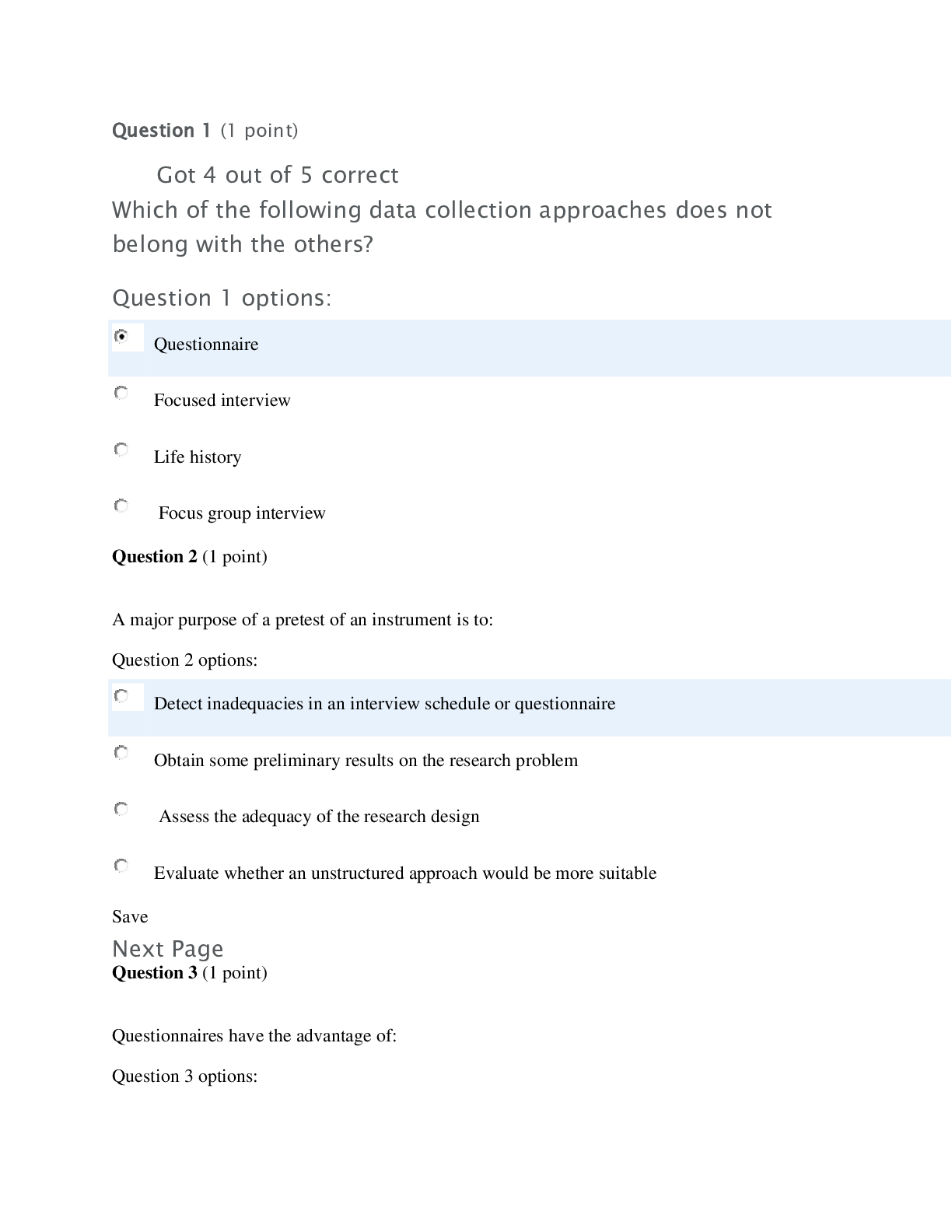


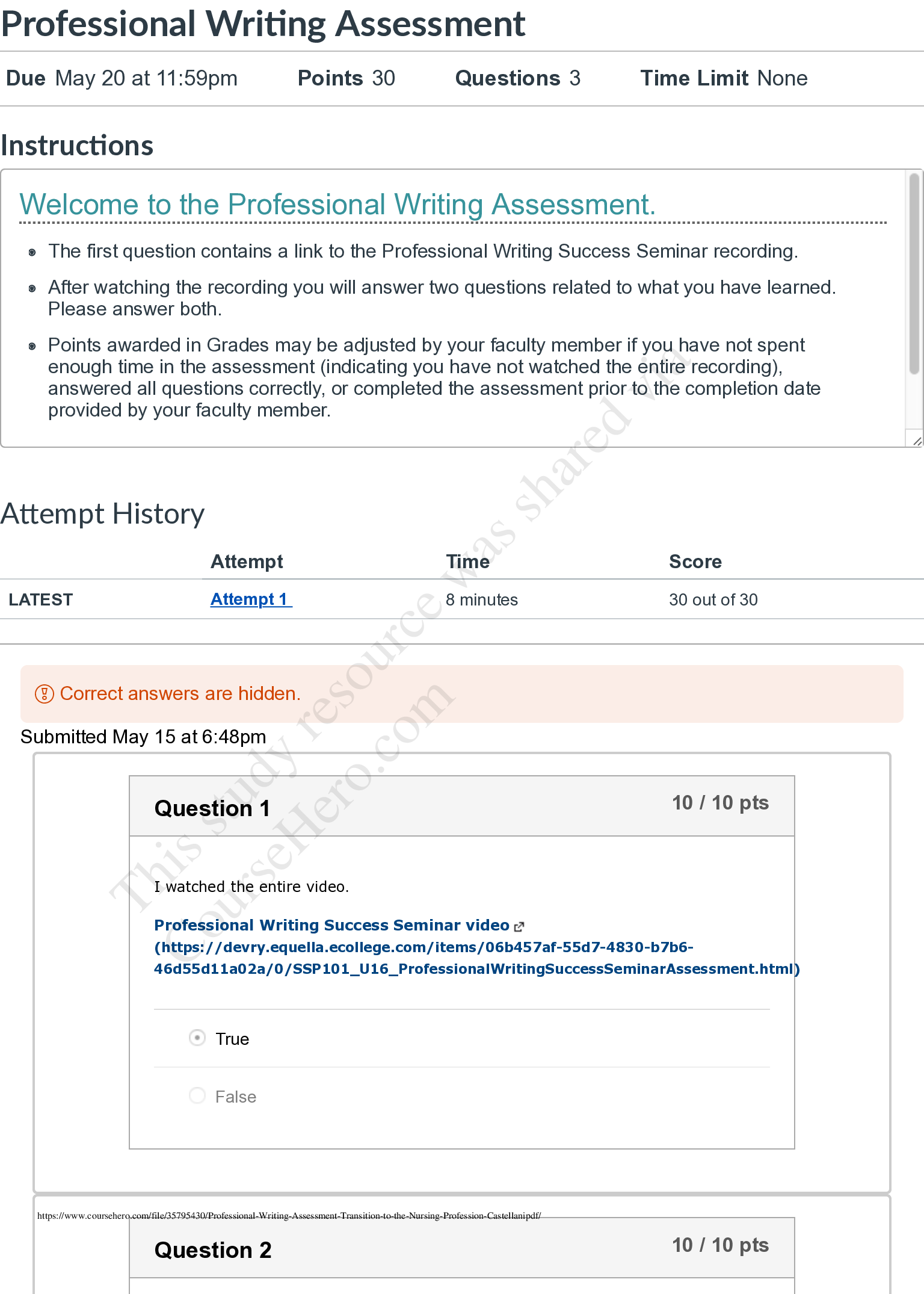



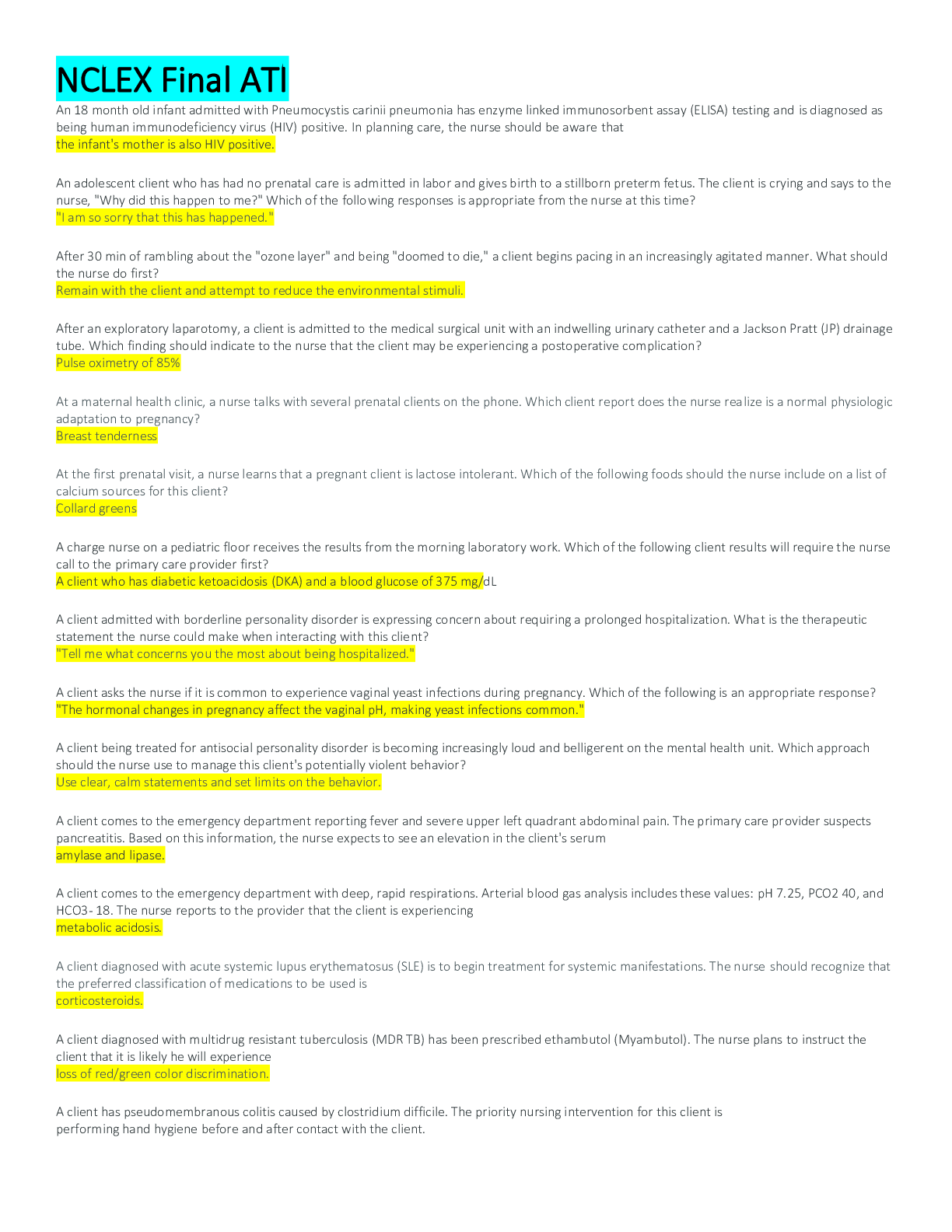
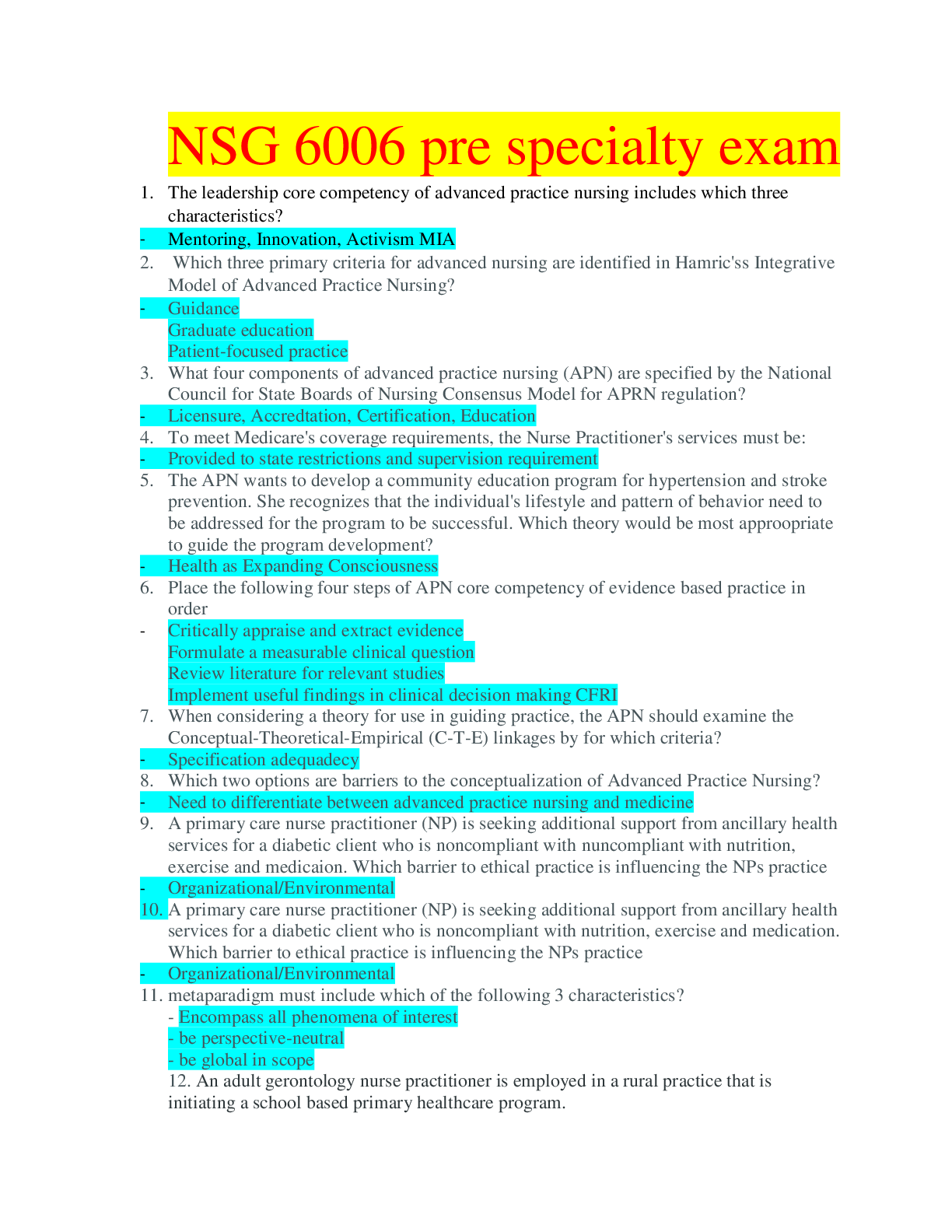
.png)
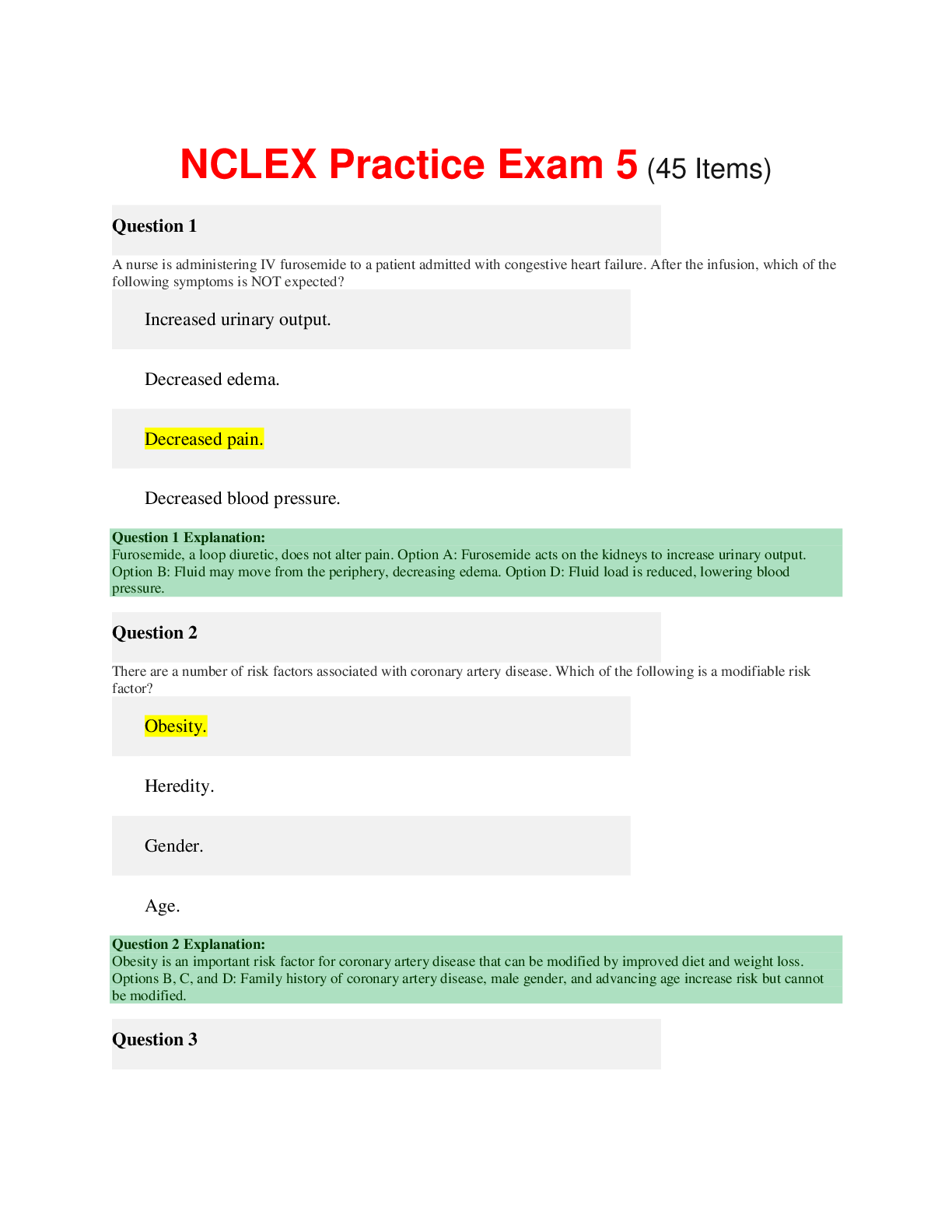
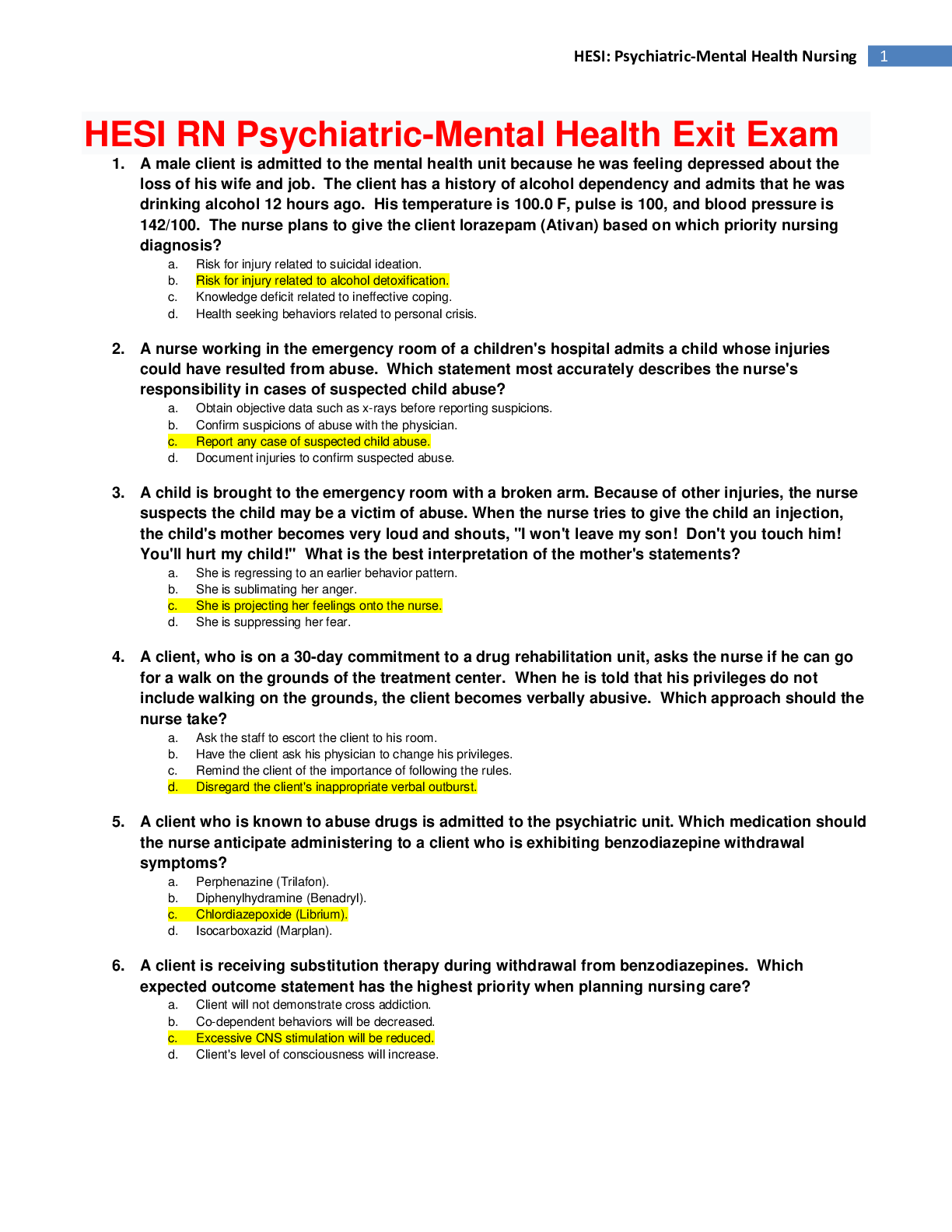
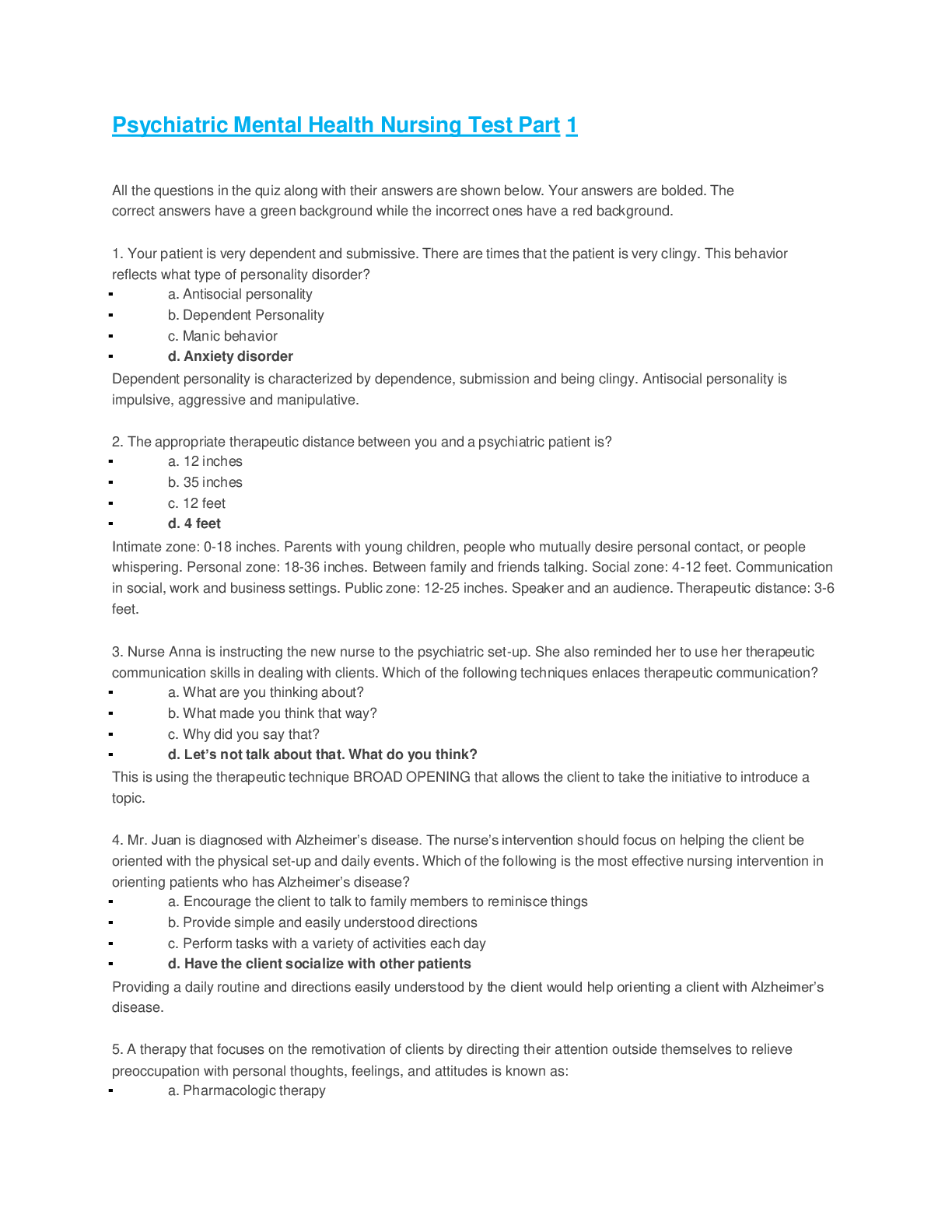
 – South university Savannah.png)
